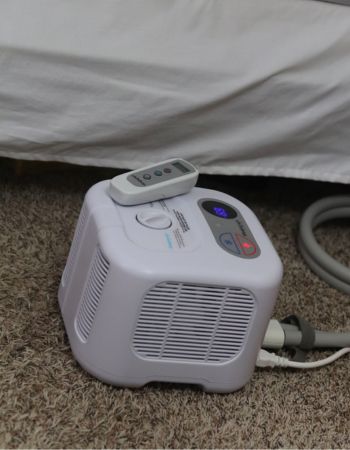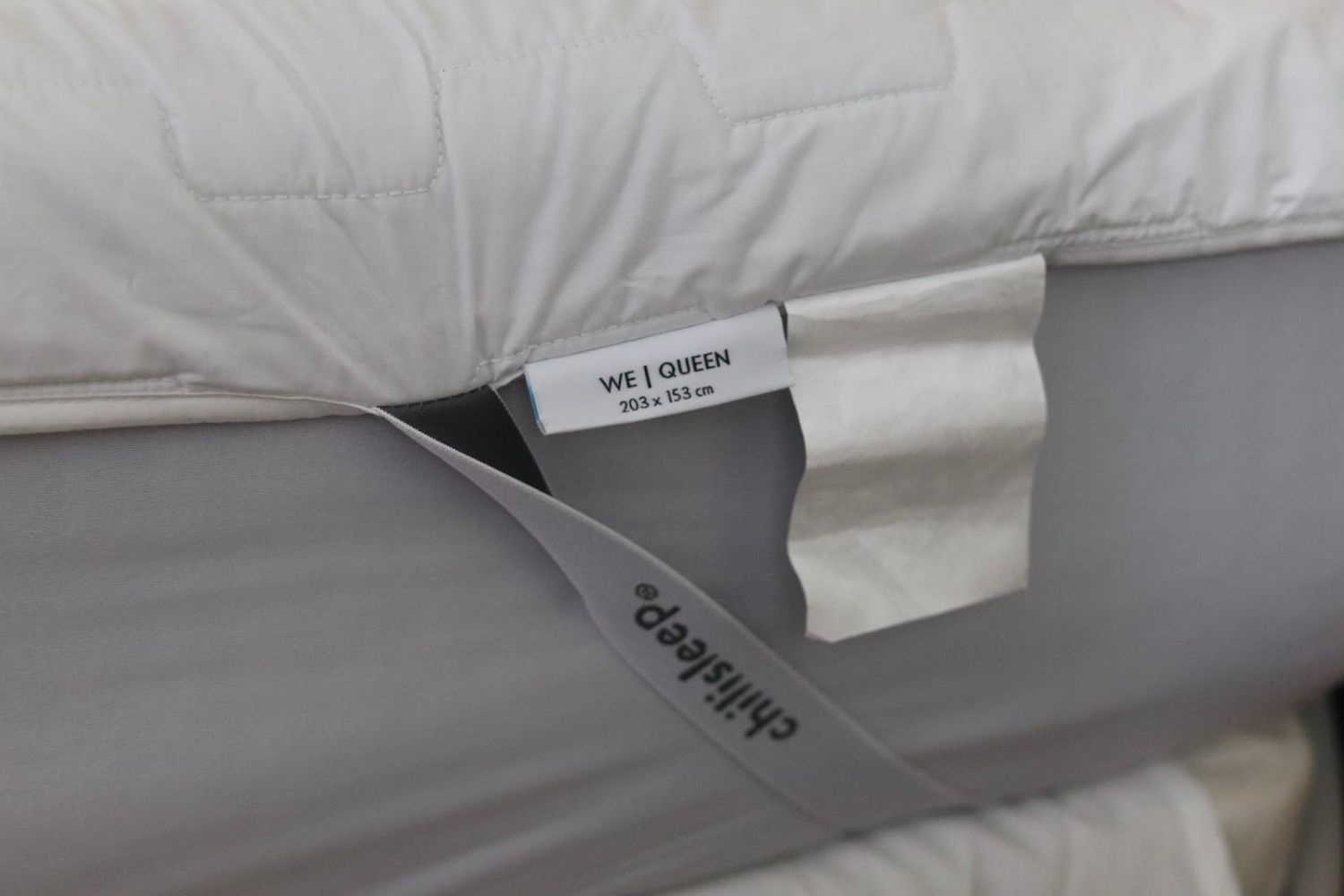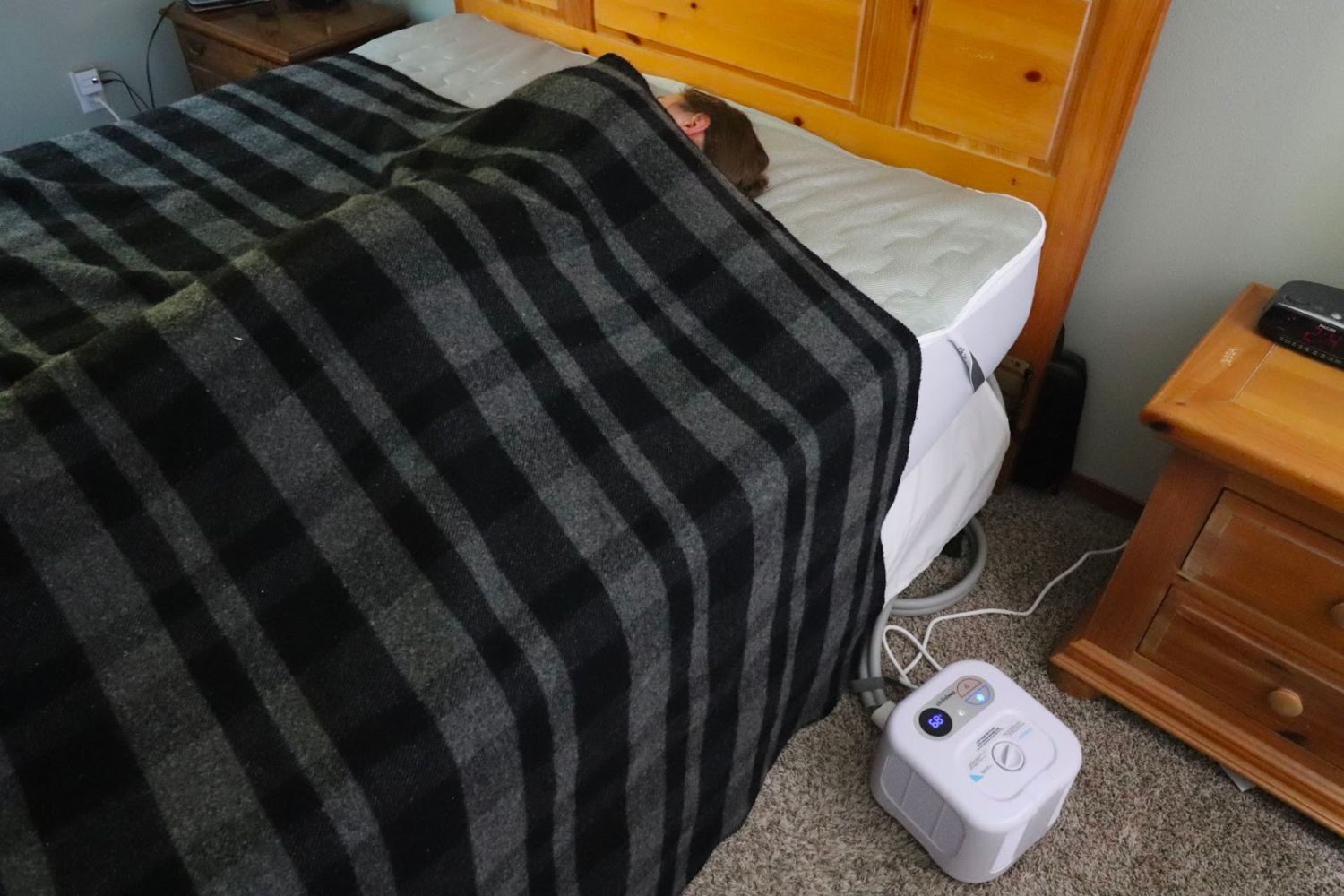

We may earn revenue from the products available on this page and participate in affiliate programs. Learn More ›
The Chilipad Cube Sleep System is engineered to circulate either heated or cooled water through tubes embedded in a mattress cover, giving users control over their bed’s temperature. There are plenty of sleep products designed to improve sleep quality, but the Chilipad is largely in a league of its own, especially for those who tend to run hot or cold while sleeping. However, it’s not the only show in town. The Chilipad Sleep System, more specifically the Cube Sleep System, graced my bed for a full 2 weeks. I’ll be comparing the Chilipad to the BedJet 3, which I also tested and which earned a spot in our lineup of the best cooling blankets. The BedJet3 is also designed to regulate bed temperature, though it uses air rather than water.
The Chilipad is made by Sleepme, a company devoted to helping customers sleep better with the help of temperature-regulating sleep systems. It employs a team of sleep experts who offer lifestyle advice to promote better sleep. Three systems are available, with the Cube being the least expensive option.
I tested the Chilipad in the main bedroom of my home, testing the “We” version designed for two users so that my husband could control the temperature on his side of the bed. The system ran every night for 3 weeks, giving me a good look at what the Chilipad can and can’t do. My overall takeaway is that the Chilipad performs well in general, but there are a few areas where I think it could do better.
Chilipad Cube Sleep System: At a Glance

Rating: 8/10
SPECS
- Temperature range: 60 degrees to 115 degrees Fahrenheit
- Weight: 10 pounds
- Cube dimensions: 9.5 inches long by 10.5 inches wide by 7.5 inches high
PROS
- Maintains a consistent temperature evenly across the pad
- Features an impressively wide temperature range
- Comes with a simple user interface thanks to a user-friendly remote control and large buttons on the Cube
- Generates quiet white noise while in use
- Pad has a dual-sided design; one side is cooler and more breathable
CONS
- Temperature changes take a while to kick in, which can make for uncomfortable waits
- Requires regular draining and maintenance to avoid mineral buildup
- Potential for condensation on the underside of the pad in humid climates
Get the Chilipad Cube Sleep System at:
- Amazon for $1,149 (queen size)
- Sleepme for $1,149 (queen size)
What is the Chilipad Cube Sleep System?
The Chilipad Cube Sleep System consists of a temperature-controlled mattress pad and a central unit that circulates heated or cooled water through tubes inside the mattress pad. The system allows users to make precise temperature adjustments according to their sleep preferences.
It comes in “Me” and “We” designs, with one made for a single sleeper and the other made for two. I tested the We model, which includes two control Cubes and two remote controls. The system offers a wide temperature range of 60 degrees to 115 degrees Fahrenheit.
Each Cube holds 13 ounces of water and measures 9.5 inches long by 10.5 inches wide by 7.5 inches high. That’s not huge, but it does take up some space and requires 18 inches of clearance around the unit for adequate air intake.
The machine-washable pad adds ¼ inch to the bed and features a polyester mesh top and polyester-cotton-blend bottom. It’s reversible, with the mesh side supposedly offering better cooling versus the polyester-cotton side. (I slept on both sides and found the breathability and comfort equal.) The pad is comfortable, and even though it’s laced with tubes for the water, I couldn’t really feel them.

How easy is it to install the Chilipad Cube Sleep System?
The Chilipad Cube isn’t hard to install. For many people, the trickiest part of the installation process is clearing 18 inches of space near the bed for adequate ventilation. The mattress pad is easy to set on top of the mattress and has elastic straps to hold it in place; I experienced no shifting or pad movement throughout testing. To mitigate the risk of condensation, those who live in a humid climate may need a waterproof mattress cover underneath the pad. That being said, I didn’t experience any condensation, even though I live near the West Coast.
I found that the silicone tubes easily connect and disconnect to the control unit and pad. After connecting the tubes, the user will need to fill the reservoir with water. For those who have high mineral content in their water, the manufacturer suggests using distilled water, which is what I did. I poured the water into the reservoir through the opening on the top with the help of my own liquid measuring cup (there wasn’t one provided with the Chilipad).
As the instructions state, the reservoir must be filled before the user turns on the unit. Once it’s full, all that’s necessary is to turn it on and wait as the Cube transfers water from the reservoir to the pad. After 1 to 2 minutes, the reservoir will need to be filled with additional water. After this, all that’s left for the user to do is sync the remote with the Cube. Once I finished reading the installation instructions, the process took me about 15 minutes. In my opinion, the setup was a breeze.
How effectively does the Chilipad Cube Sleep System heat and cool?
The Chilipad does a better job of cooling than heating, in my opinion. The process is controlled with a simple remote with three buttons: warmer, cooler, and on/off. There are also control buttons on the Cube unit that can be used instead of the remote, if needed.
It took me a few nights to find a temperature sweet spot, which for me ranged from 80 degrees to 87 degrees Fahrenheit on cool nights and 70 degrees to 75 degrees Fahrenheit on warm nights. However, I easily overheat at night, so I didn’t make it into the 80s very often. Dropping the pad temperature into the low 70s put a stop to my nighttime sweating. It almost felt as if the pad pulled the heat from my body so that all night long, it felt like I had just lain down in cool sheets.
Aside from its simple button layout, the remote control also features a digital temperature display, making it easy to adjust the temperature precisely. Oddly enough, the warmth and heat never felt as warm or cold as the temperature indicated. Part of that is due to the subtlety with which temperature changes take place. Users aren’t blasted with heat or cold, which is something the BedJet can do. Instead, the Chilipad slowly warms or cools the bed. I would describe it as a sensation that spreads across the entire surface of the pad, rather than emanating from a single source.
I found the Chilipad more useful for cooling than warming; when it came to warming up, the heat radiated so slowly that I found myself feeling cold for a long time while I waited. Eventually I would warm up, but when I’m cold in bed, I prefer being able to heat it quickly. That can’t be done with the Chilipad.

What kind of maintenance does the Chilipad Sleep System require?
Any device that utilizes water requires a certain amount of maintenance, and the Chilipad is no exception. It comes with a packet of cleaning solution for each Cube (one of which burst during shipping, in my case). The control unit and pad require monthly cleaning. I cleaned the control unit after 2 weeks by adding the included cleaning solution to the water in the reservoir and leaving the system on for 1 hour.
I also tested the draining process, which is something users will need to do if they’ll be storing the Cube for an extended time period. The draining process is laborious and tricky. The system comes with a drain key that’s used to drain both the pad and the Cube, and this is done by pressing the key into the outlets to release water.
The Cube wasn’t too hard to drain, and I drained it directly into the bathtub. However, the pad was more problematic. It’s necessary to keep the pad elevated above the drain point, but because the pad is made of fabric, it’s hard to prevent it from folding over and collapsing during this process. After a 45-minute wrestling match between me and the mattress pad, I still wasn’t convinced I had gotten all the water out, and I can’t confidently say that my pad and Cube wouldn’t grow mold if I were to store them long term.
However, the Chilipad gets bonus points for its machine-washable pad. I tossed it in the washing machine on the gentle cycle, then put it in the dryer on low heat, and it came out looking like new.
While the maintenance isn’t exactly difficult, it’s not easy or convenient. It would help if the pad had some kind of loop or hook on one end so that it could be hung while the water drained.
Is the Chilipad Sleep System worth the money?
There’s no doubt that the Chilipad is pricey, costing as much as some mattresses. Plus, there are other hidden costs users will incur after they’ve already dropped a sizable chunk of change on the system. For example, it’s necessary to buy the monthly cleaning solution (which costs $24 for three packs) and distilled water. The upkeep costs aren’t high, but the Chilipad isn’t a one-and-done kind of purchase.
The Chilipad did an impressive job at keeping me cool and allowing me to make precise temperature adjustments based on how I felt at any given moment. Those who suffer from night sweats, hot flashes, or simply tend to sleep warm can get relief with this system. It’s also a nice option for couples who have different nighttime temperature preferences; my husband stayed warm on his side while I stayed cool on mine.
However, for users who don’t fall into the overheating-makes-it-so-I-can’t-sleep camp, the Chilipad probably costs more than it’s worth.

Is the Chilipad Sleep System right for you?
Anyone who struggles with night sweats or overheating can definitely benefit from the Chilipad. After I did some temperature tweaking, the Chilipad made me feel like I was sleeping in a perfectly temperature-controlled environment. The temperature-controlled water heats or cools the surface of the pad evenly, preventing some parts of the body from getting too cold while the rest of the body stays warm.
As mentioned earlier, I also tested the BedJet 3, a system that achieves similar ends through different means. The BedJet heats and cools air before blowing it into the company’s proprietary pocketed sheet (or directly between regular sheets). Both systems have a heating/cooling unit that sits next to the bed.
The Chilipad pad does a better job at evenly cooling or heating the body. The BedJet, even when using specially designed pocket sheets, tends to cool (or heat) more directly in the area where the air enters the bed. The Chilipad’s consistent cooling across the entire pad is what helped with my overheating more than anything.
Where I don’t think the Chilipad shines is with the heat factor. Yes, it can heat water to 115 degrees Fahrenheit, but it feels more like sleeping in a bed that a warm body just left, not truly warm. It wasn’t comforting, nor did I find it satisfying. When I got cold, I wanted to feel warm instantly—not in 5 minutes. And on cold nights, it simply wasn’t enough.
In contrast, the BedJet allows users to adjust the temperature and the fan speed, so it’s possible to blast the bed or let the heat slowly trickle between the sheets. When it comes to staying warm, I prefer the BedJet, hands down.
The Chilipad also lacks some of the finer control features offered by the BedJet. The BedJet can connect to a Bluetooth remote or an app. In the app, users can set different programs to adjust heating and cooling based on sleep cycle and biorhythms. For example, I don’t usually overheat until 2 a.m. With the BedJet, I can program it to start cooling the bed before I get too warm. The Chilipad doesn’t have that option. The BedJet also has an adjustable timer, whereas the Chilipad turns off after 10 hours. In general, the Chilipad lacks the customizable settings offered by the BedJet.
Overall, however, for those looking for a satisfying cooling experience for a better night’s sleep, I would not hesitate to recommend the Chilipad Sleep System. In my opinion, the cost is worth it for those who struggle with overheating at night.
Where to Buy the Chilipad Cube Sleep System
Get the Chilipad Cube Sleep System at:
- Amazon for $1,149 (queen size)
- Sleepme for $1,149 (queen size)
Meet the Tester
Stacey L. Nash has written about sleep and sleep products for 4 years, testing everything from mattresses and bedsheets to blackout curtains and duvets. Her work has appeared on The Spruce, Popular Science, and SportsIllustrated.com, along with her work on BobVila.com. She takes a straightforward approach to product testing and reviews to give readers a hands-on perspective at how each product functions in everyday life.
